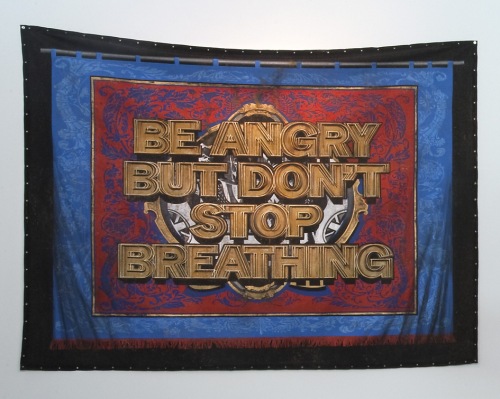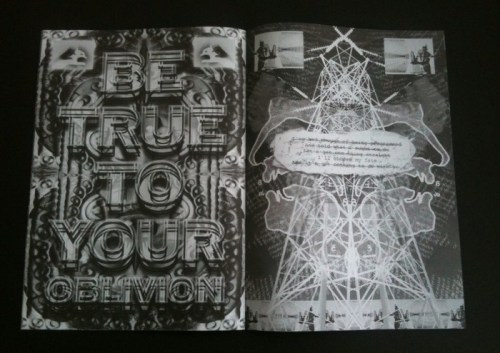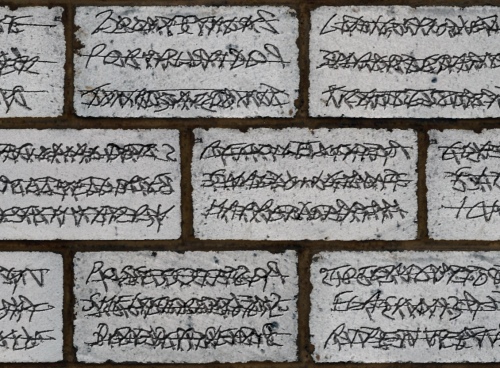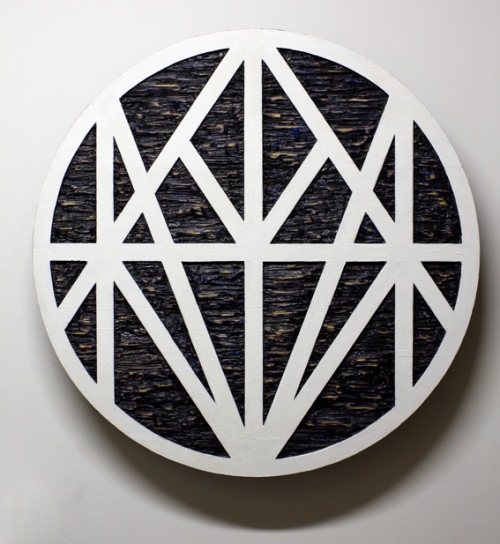
Mark Titchner performing at Warsall New Art Gallery in front of his installation “Be Angry But Don’t Stop Breathing,” September 2, 2011. Photo by Amelia Ishmael.
In September of this year I traveled to Wolverhampton, U.K. to present some of my research on Black Metal and contemporary art to the Home of Metal Conference, a three-day long event that brought together Metal academics—yes, there are such things—from across the U.S., South America, Europe, and the Middle East. In addition to the Conference, Capsule also organized an extensive program of events under the Home of Metal title throughout 2011—including film screenings, performances, and gallery exhibitions—to celebrate the Black Country and Birmingham as the birthplace of Metal. One of my favorite art events included was Mark Titchner’s solo exhibition “Be True To Your Oblivion” featured at the New Art Gallery in Warsall.
Mark Titchner is a British artist who is probably best known for his text-based works. Frequently assuming the format of large billboards, these works pull quotes from a wide range of sources—from Black Sabbath to the Black Panthers, and countless smart, consumer-targeted phrases in between—to create inspiration-speak such as “if you can dream it you must do it.” Titchner’s art practice is located somewhere between advertising, social activism, political and cultural criticism, and motivational speaking. He has exhibited in solo exhibitions at locations including Vilma Gold and the Tate Britain in London, the Macedonian Museum of Contemporary Art in Thessaloniki, Peres Projects in Berlin and L.A., the Venice Biennale, and the Arnolfini in Bristol. In 2006, he was a Turner prize nominee.
On September 2, Mark Titchner gave a performance at the New Art Gallery in front of his installation “Be Angry But Don’t Stop Breathing;” the next day he was joined by the artists Nicholas Bullen and Charlie Woolley for a panel discussion at Lighthouse on the University of Wolverhampton’s campus. I was fascinated with Mark’s exhibition, and the discussion that ensued at the Lighthouse shook me out of my jet-lag long enough to attempt hijacking the conversation towards issues of interdisciplinary art practices, Metal as Sound Art, and where subculture ends and “high culture” begins. I met with Mark afterwards to ask if I could follow up with him in the future about his work. The following interview is an extension of this discussion.
Amelia Ishmael: I’d like to start by asking about the way your artwork incites public participation. From the 2006 “Thought is Signal” project in Bristol to the 2011 stage installation “Be Angry But Don’t Stop Breathing” at the New Art Gallery in Walsall, part of your practice involves handing the mic over—sometimes quite literally—to the public. This type of activism seems based on the notion that, as an artist, you have a particular platform to speak to larger groups of people; it draws attention to the artist, and artwork, as a sort of mediator. Can you tell me about this practice? Do you have an aim in mind with who the public is speaking to… is it a political entity? Or does the work exist as a broader exercise in clearing the throat, reacting to one’s world, and speaking out?
Mark Titchner: There are a number of intentions with these “interactive” works. The first is a very simple idea about the functional potential of sculpture, that it becomes a device rather than an object. When I started to think about this concern a number of years ago, I suppose that I was thinking about creating the notion within the viewer that the work would always remain lacking or incomplete without their participation. This is obviously the case with any work of art, but I wanted to play with this idea by trying to replace some type of mental process with a “use” one. It was also very simply about the viewer taking some form of responsibility. Secondly, these works are about the way that we occupy public spaces, how we behave in them, and what a public space actually is. Artists do have a particular platform, but this is complicated in a gallery/museum situation as we have a space with a very clear hierarchy, and we learn to behave a certain way in these spaces. Though I think that this is a situation that is changing, given the emphasis on education, particularly for the young.
I think that the territory of the artist as mediator is a tricky one, because I always feel that it is slightly easy to walk away from a situation. One important aspect for these works is that they introduce an element of chance to a static work, what I wish I had the ability to do with the Walsall work was to record all the audio produced by the participants. Apparently beat-boxing was very popular! Actually that is one thing about the failure of these works: that in an ideal world you might think that you are setting up an open political platform, notionally, but it gets used to make fart noises or the like. Its very openness is a problem, and I think that is my failure as an artist, because I have some experience of the reality of showing these works.

Detail from “Be Angry But Don’t Stop Breathing,” 2011. Acrylic on canvas. Image courtesy of the artist.
AI: “Be Angry But Don’t Stop Breathing” is an incitement to the public, but I’ve read that this is also a phrase gleaned from a poster for Dusan Makavejev’s 1971 film on Wilhelm Reich, “Mysteries of the Organism.” Gleaned from political, philosophical, and psychological works and song lyrics, language and text is a prominent aspect of your work. What draws you to these statements and how are you reappropriating them in your work?
MT: Yes that is correct, the text “Be Angry But Don’t Stop Breathing” was borrowed from a film poster. I was very interested in the work of Wilhelm Reich when I made the first variation of this work in 2003, and at that time I was very much concerned with the appropriation of text. I only started using my own texts relatively recently. My interest initially was how, by separating the voice of the author from the text, one changed its interpretation. That is, one removes the hierarchy of authorship that tells us that we should interpret a philosopher’s words differently from a pop lyric, even if the actual text is quite similar. I would look for texts with a certain kind of philosophical bent but that used very simple and direct language. You could say it was a process of creating an equivalence, and this was echoed in a coherent graphic style that I developed amongst those works. It’s actually a little sad because in a way, these are my most popular works. People say to me: “Oh, I really like that text, it inspired me to…”, when actually the whole project had to do with the lack of meaning, about reflecting on a situation where the array of possibilities replaces a depth of engagement. I was reflecting on my own lack of belief—be it moral, spiritual, or political. I suppose that is something that most people can relate to.
AI: You might know already, that my interest in your artistic references perks when you are referencing Metal and, specifically, Black Metal lyrics and modes. During the Home of Metal conference you mentioned that your poster “Be True to Your Oblivion,” installed at the New Art Gallery Walsall, was directly inspired by a quote in Scott Wilson’s article in the Black Metal Theory Symposium’s first publication Hideous Gnosis. And the fanzine that accompanied your exhibition here drew upon not only d.i.y. culture, but also integrated parts of Hunter Hunt-Hendrix’s “Transcendental Black Metal” manifesto, also from Hideous Gnosis. Can you tell me more about how you are using these references and your relationship with Black Metal?
MT: Well spotted on both counts. Scott Wilson was quoting “The Baphomet” by Pierre Klossowski, where the line is “be faithful to your oblivion.” I made a minimal adjustment by exchanging the word “faithful” to “true.” The change to the idea of “Truth” was a nod back to Heavy Metal and the idea of “True Metal”—and by extension “True Norwegian Black Metal,” etc. The phrase contains those two poles of faith/nihilism, dedication and destruction; a contradictory pairing but an extremely productive space.
I’m very much interested in the idea of the manifesto or the exegesis, the moment of lucid understanding, and the inherent problems of how one can give concrete form to this kind of transcendent rapture. This is why I tend to use imperative language in my works; I want to make it clear that what is being communicated is vital and truthful. This is in fact a tactic that is designed to draw attention to the way that a certain type of language is used in certain situations. In that sense, I am more interested in the delivery of text/language than in what is actually being said. My interest is really in power relations and manipulation.
Black Metal theory is interesting because it throws up all kinds of debates about identity and the transcendental. I also enjoy the slightly absurd notion of this debate spiraling out of a derided subgenre of a derided genre.
As for my relationship with Black Metal, it is purely as a type of music that I have listened to and enjoyed—in the same way as I listen to Hip Hop or electronic music. I’m certainly not a purest, though right now I favour a return to a more misanthropic, caustic form of BM rather than the pastoral—which is gaining increasing attention.
AI: Another reference to Black Metal—here its logos specifically—is found in the installation “Breezeblock,” which is covered with illegible mirrored signs that appear to be obfuscated words visually carved into “bricks,” crossed out, and creating a visual density where language is an uncodable symbol. How do these words relate to your interest in sigils?
MT: That work really wasn’t planned to turn out quite as it did! I had to write a funding application for that piece and wrote a very clear description of the final work. When I got around to actually producing it I found very little interest in making a work which felt like it had already been completed. What actually happened with “Breezeblock” is that I wrote out around 3,000 neologisms that related to sound. These were—virtually—carved into brick, then mirrored to make them illegible and crossed out. It was quite an exercise to come up with the initial neologisms, so there was definitely something nihilistic about making them illegible. I should also add that the mirroring of the words did give them the look of the BM logo, but also the graffiti tag. I’m very much interested in what happens when language is used in a way that you wouldn’t normally expect—be it reducing the spoken word to a grunt, or the written word made illegible.
When I was younger I was very interested in William Burroughs’s idea of the “Word Virus” and the relationship of language to control. This is an extension of the idea of the language as being the constituent component of the human universe. Therefore, it is important to treat language like matter in that it can be of different densities or offer different reactions. The sigil is an attempt to explore the linguistic connection to the subconscious and the conscious mind, and to break the causal bonds. In this situation language/reality becomes a malleable substance that can be manipulated, rather than one that we react to entirely passively. This might all sound slightly ridiculous… but I think that it is entirely healthy to have a somewhat absurdist attitude to something so monolithic as language.
AI: In the Walsall exhibition, your use of text in “Be True to Your Oblivion,” is a clear and consciously accessible rendering of text which is working in a mode similar to a public announcement or advertisement. Yet, you also explore words in more subliminal modes—such as in “Ergo Ergot”—and even magical modes—in the carved panels “Love” Aids” Riot” Hope,” where the overlapping letters of each word creates a sigil. What necessitates these multiple approaches? Do you consider these works to posses a particular duration, as the viewer must spend time to reflect on and untangle the words?
MT: These approaches are a little like different tones of voice, which in the end have the same effect. For instance you might do what you are told because someone shouts at you, or maybe because you are seduced by a gentle whisper in the ear. I’m just trying to find a visual equivalent. Also, I think it would be a little dull if all the works had the same kind of tone or pitch. Duration is very interesting to me. My work is very much influenced by advertising that employs both the need to immediately communicate a message and the slow construction of something like a brand identity. My initial use of text was influenced by trying to quickly communicate with an audience that might only spend a few seconds looking at a work and then move on.
AI: Is your interpretation of words into sigils a means to turn them into a sort of energy accumulator?
MT: Words are already energy accumulations; the point with sigils is to try and actively use that energy to a specific end. That probably sounds dreadful, so I should probably point out that I am more influenced by the Self Help/Self Improvement movement than by any kind of New Age beliefs.
AI: Can you tell me about your use of everyday materials and your interest in magic?
MT: I started off using materials that I found in waste bins or skips and, at best, materials that could be found in a general hardware store. Practical and functional materials that we find all around us in the city: concrete, steel, wood. I think that it is important to work with these materials that are readily available, and also already deeply enmeshed in contemporary life. I suppose there is a very basic idea of the alchemical here, of making the base transcend.
Transformation is my interest in magic, and I would definitely say that my interest is in transformation, not magic. What I was saying earlier about language seems very magical in a sense in that it is about trying to alter reality in some way.
AI: You have also turned your name into a sigil in the carving “The New MT,” stained with your own blood.
MT: That’s correct. That work was made with the idea of creating a signature or monogram that announced my intention to engage with a more willful practice as an artist. There is a history within art of the artist announcing a kind of “year zero” for themselves—John Baldessari’s public destruction of his works in 1970 would be a good example. The work is also a self-portrait, or at least references that genre, so the inclusion of my blood was playing with this, as the work has been marked with and carries my genetic data. From a magical perspective the work could be seen as having been “charged” with my blood.
AI: In preparing for this interview with you, I kept coming back to this concept “so much noise to make a silence,” which you return to throughout your work. It is impossible to ignore your references to sound, even when there is no direct sonic aspect. In “Breezeblock” you’ve built a wall of text that is impenetrable; in “If You Can Dream It You Must Do It” the sculptural outlines of the text seem to reverberate; and in “N(I)B” the absence of sound in Nicholas Bullen’s “mouthing” of censored words is deafening. Can you tell me about your interest in the concept of “so much noise to make a silence”?
MT: This all really stems from an interest in the distance between potential and realization, whether in an object or in an individual. Quite often in the works there is something missing, a lack. That might be the viewer’s voice in “Be Angry But Don’t Stop Breathing,” or the missing sound from a set of giant wind chimes, or from Nic’s vocal performance. These objects are all defined by what is missing from them, and engender a sense of frustration. To me this relates strongly to the constant state of desire that is incubated in order for capitalism to work, and it also relates to a contemporary alienation from politics, spirituality, etc. Maybe it’s just because, in a way, I would rather be a musician than an artist, and I’m just trying to vent my frustration! “So much noise to make a silence” does seem to sum a lot of contemporary life up to me; an infinite array of information and objects but to achieve what end? It’s actually a line I borrowed from a Crass song.
AI: Thank you Mark!








Pingback: ‘BE TRUE TO YOUR OBLIVION’ | The New MT
Pingback: More noise, more silence, sigils, and word viruses | The New MT
Pingback: We Find Wildness